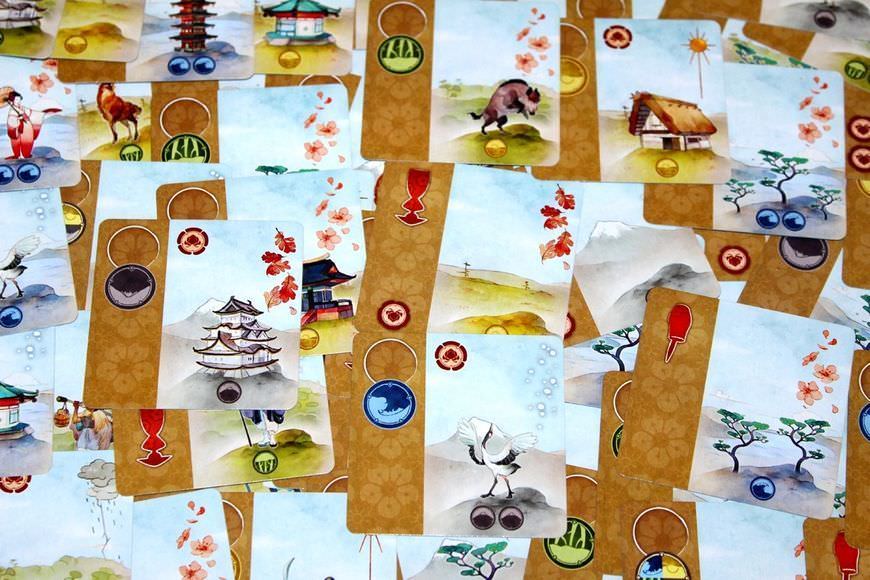[Kanagawa Review]
A Zen-like card drafting game with Japanese art - Become a disciple of Katsushika Hokusai and complete a beautiful hanging scroll
Become an apprentice at the Edo period master Katsushika Hokusai 's painting school and paint the most beautiful landscapes that harmonize Japan's nature and culture - that is the world of Kanagawa .
In this article, we'll take a closer look at the appeal of this game, which is praised for its beautiful artwork that blends well with the theme, and for being both interesting and relaxing. We'll also explain in detail what it's like to play it, why it's enjoyable for beginners and experienced players alike, and what you should know before purchasing.
Game Basics
First, let's introduce Kanagawa 's basic specifications and features.
Number of players, time, and target age
- Number of players: 2-4 (optimal 4)
- Playtime: 45 minutes
- Ages: 8 and up
Designer/Artist
A collectible game from the award-winning duo Bruno Cathala (Kingdomino) and Charles Chevalier (Ark Nova), featuring especially talented and beautiful illustrations by Jade Mosch .
Core Game Mechanics
Kanagawa is a game that combines card drafting, hand management, set collection, and a bit of worker placement, with a fun push-your-luck element.
Each round, a row of cards corresponding to the number of players is placed on the impressive bamboo "school" board, and players are forced to choose between taking a card or passing and waiting for more cards.
The acquired card has two uses:
- Used as a hanging scroll (print) : Arrange from left to right, and score points for rows of the same color or seasonal composition.
- Use as an Atelier (Studio) : Flip the card upside down and slide it into the Studio column, which improves your abilities and gives you access to different landscape types, extra victory points, and different ways to manipulate other physical elements of the game.
The appeal of Kanagawa: A perfect balance of Japanese theme and deep strategy
Here are four reasons why Kanagawa is loved by so many players.
1. The delicate dilemma of "wait or take"
Kanagawa boils down to limited resources, and the question at its core is, "Do I take the resources for myself before someone else claims them, or wait until they're more valuable?"
If you choose to take a card, you can add it to your print or studio, but if you pass, you risk taking the card your opponent wanted and wait a turn for more lesson cards to be added to the board - a truly fun Push Your Luck experience.
2. Strategy breadth due to card versatility
It's played using multi-purpose cards, and what's appealing about it is that each card (when drafted) can be used to either improve the player's studio, giving them access to different scenery types, additional victory points, and different ways of manipulating other physical elements of the game, or to add to their masterpiece (where the majority of the game's victory points are earned).
Even with the same cards, your strategy can change dramatically depending on how you use them, making for a fresh experience every time.
3. Perfect harmony with artistic themes
Kanagawa aesthetic - It's been praised for fitting into the wonderfully elegant Japanese visual style of works like Tokaido and Lotus.
The first thing you'll notice about this game is that the artwork is exceptionally well done. All of the artwork on the cards blends together nicely, and many say the overall look and feel of the game is noticeably better than most board games.
4. Accessible yet profound experiences
The game is easy to teach and play, with one customer praising it for being "a simple yet deep engine-building experience."
Some say if you picked up Tokaido and really wanted to like it but found it too slow, this might be for you, and it's more enjoyable and well-paced than similarly themed games.
Concerns and solutions
Along with the wonderful things about Kanagawa , we will also introduce some concerns and how to deal with them.
1. The rulebook is difficult to understand
The rules are out of order, things that should belong together don't, and you have to read through them all before you can figure out how things relate.
Solution : This issue can be resolved by having new players watch and learn the "How to Play Kanagawa " video. By learning from the video and then actually playing, players will be able to enjoy the game smoothly.
2. The physical difficulty of handling cards
The only real negative aspect of Kanagawa comes from its "slide cards under other cards" mechanic: the most recently added card always sits flat on the table, which some have pointed out is a real pain, as you have to lift up the stack of cards every time you want to add something to the display.
Solution : The effort of purchasing card sleeves and cutting them down to size with scissors was totally worth it. These card sleeves significantly improved the experience, and now Kanagawa is always welcome at the table, according to the advice.
3. Low player interaction
It's not very competitive, and focuses on what you're doing, not what others are doing. It has a medium level of player interaction, so it may not be satisfying for players looking for intense strategy.
Solution : Kanagawa 's theme evokes relaxation and meditation for me, and the gameplay is easy to replicate. Approach it with the mindset of a great family game to enjoy. Think of it as a game about the joy of creation, rather than competition.
Recommended for these people and occasions
We will introduce the players and usage scenarios that Kanagawa is perfect for.
Perfect for family gamers
It's a great game for casual board gamers who want to play something beautiful. It's relaxing yet engaging to play. There are good choices every turn, but not enough to cause analysis paralysis, and there's just the right amount of random luck, making it fun for the whole family.
People who want a sense of fulfillment in a short amount of time
This is a great game to play a few times a night to give everyone a chance to win, rather than investing in a big two-hour game. It takes a maximum of 30 minutes for two players, so you can play as many times as you like.
Art lover/Japanese theme lover
Kanagawa is the perfect blend of art, history, and strategy, making it a fun game for anyone who appreciates cultural themes and strategic gameplay, and the sense of accomplishment you get from looking down at your amazing creation in the finished game is incredible.
As an introduction to board games for beginners
One of these simple, elegant, and subtle games that will appeal to both beginners and experienced players, making it an excellent introductory game. Light strategic decision-making, medium player interaction, and short gameplay make it accessible to a wide audience.
Use at cafes and board game gatherings
It's small and takes up very little table space, making it suitable for use in cafes. When placed on a table, it looks inviting and sophisticated, creating the kind of atmosphere you'd expect to find surrounded by someone who knows a disturbing amount about sushi, a small orchestra, wine, and cheese.
Kanagawa is a beautiful game that offers a meditative experience. Every card is designed to fit into the background, so that when completed, the masterpiece flows together, at least in terms of topography, sometimes with dramatic seasonal changes, sometimes with soothing transitions, and the beauty of the finished piece will leave an impression long after you've played.
This is a must-play for anyone who enjoys Japanese themes and art, and who wants a satisfying gaming experience in a short space of time.
Check the product on the online store page
Free shipping throughout Japan. Orders placed before 3pm will be shipped the same day.
Reference source/quote source

